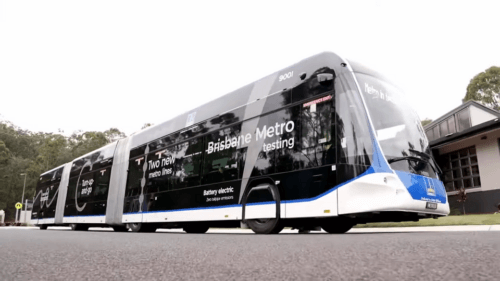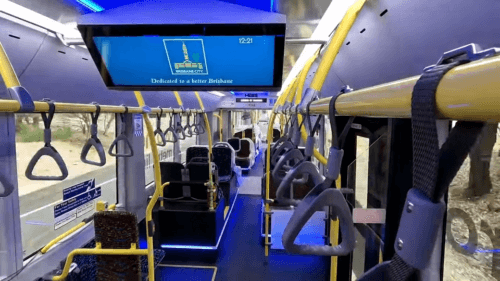
AUSTRALIA
With services due to commence in 2024, testing of the pre-production Hess LighTram25 for Brisbane Metro is ongoing in the Australian city. Designed in Switzerland and based on similar vehicles in use in that country and elsewhere, the new bi-articulated battery electric vehicles promise to reshape perceptions of commuting in Brisbane, and how operators consider the future of public transport.
Sold as the ideal mix of the appeal of light rail and the flexibility of a bus, Hess CEO Alex Naef told local trade media that the Swiss company is delighted that the project has moved beyond the initial testing and acceptance stage. “We feel privileged to contribute to a public transport solution that is leading the way in Australia,” he said. “We always knew that LighTram25 would offer something Australia hasn’t seen before: a vehicle capable of quietly, efficiently and sustainably transporting large numbers of people without being reliant on rail infrastructure. The testing process was extremely rigorous and involved numerous evaluations, inspections and assessments, validating our belief in the product.”
Charging infrastructure is yet to be completed, but the buses will use on-route fast charging to minimise the size and weight of batteries on board. “The charging system for these vehicles can recharge the bus in under six minutes. That’s exceptionally fast, but we’re mindful that we also needed to keep the batteries light and the vehicles in frequent operation,” he added. “Our philosophy is that Hess vehicles are there first and foremost to carry passengers, not batteries.”
Hess Regional Manager for Australia Peter Dale explained that over 15,000 people has taken the opportunity to view the new bus, and that the response has been encouraging. “Those who attended the events were really impressed. We got a range of highly positive feedback on numerous aspects of the vehicle,” he told Australasian Bus & Coach. “It’s one thing to look at a spec sheet, but another to ride on the vehicle and experience the spaciousness and features for yourself.

He also praised the driveability of the 25-metre long dual-articulated people-movers. “When you match that with its manoeuvrability – how it effortlessly handles a roundabout, for example – you have people talking about a true best-of-both worlds mode of transport.”
Numerous aspects of the vehicle were evaluated during an initial three-month testing and technical evaluation period which started in April. Following successful competion of the trials, Brisbane City Council announced that it would go ahead with its order for the remaining 59 vehicles, which will be Australia’s first bi-articulated buses. Peter added: “It was pleasing that the testing process was so successful, in part because it wasn’t your typical tender process. Historically, operators put out a series of design specifications: length, width, and so on. In this case, what we were asked to respond to was a series of performance specifications.
“We began with qualitative requirements relating to accessibility and passenger flow, and with these in mind, we worked on the quantitative side of the design. What we have now is something we’re very proud of, a vehicle with three large and accessible mobility aid bays in the first compartment, an automatic electric ramp, hearing loops and the ability to communicate with the driver via help points, and much more.”
“We’re working with Brisbane Metro, Transport for Brisbane and we’re continuing our long and proud partnership with Australian bus body builder Volgren. Its own extensive association with council makes it an ideal partner, and its Eagle Farm facility has already played an important role in the testing and technical evaluation process.”

